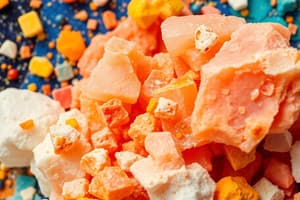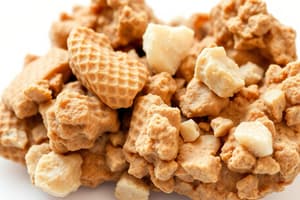Podcast
Questions and Answers
Which of the following is FALSE about the classification of minerals?
Which of the following is FALSE about the classification of minerals?
- Microminerals are also known as Trace Minerals
- Macrominerals are required in amounts greater than 100 mg/day
- Iodine is an example of an Ultra-trace mineral
- Microminerals are required at levels less than 1 mg/day (correct)
Which of the following is consistent with the definition of Minerals?
Which of the following is consistent with the definition of Minerals?
- Mostly Inorganic
- Occur naturally on the Earth (correct)
- Physical properties change in relation to gravity
- Essential to Nutrition only in very small amounts
Which of the following is consistent with the Classification of Minerals?
Which of the following is consistent with the Classification of Minerals?
- Trace and Ultra Trace Minerals are known as Microminerals (correct)
- Macrominerals are required by the body in level less than 500 mg/day
- Trace Minerals are required by the body in levels between 1 mg and 1000 mg
- Ultra-trace minerals are required by the body in levels greater than 1 mg per day
How much calcium is recommended daily for adults 19-50 years old to support bone health?
How much calcium is recommended daily for adults 19-50 years old to support bone health?
Which of the following is the most abundant mineral in the body?
Which of the following is the most abundant mineral in the body?
Hydroxyapatite is made up of the following, EXCEPT:
Hydroxyapatite is made up of the following, EXCEPT:
Hydroxyapatite is composed solely of Calcium
Hydroxyapatite is composed solely of Calcium
It can be dissolved with Acid
It can be dissolved with Acid
Most (98%) of Calcium is found in the Skeleton in the form of Calcium lons
Most (98%) of Calcium is found in the Skeleton in the form of Calcium lons
With Phosphate it can form Hydroxyapatite
With Phosphate it can form Hydroxyapatite
Calcium is a good second messenger for cells that's why it is more abundant intracellularly
Calcium is a good second messenger for cells that's why it is more abundant intracellularly
Which of the following is true about calcium absorption?
Which of the following is true about calcium absorption?
Calcium immediately binds to this protein upon entering the enterocytes
Calcium immediately binds to this protein upon entering the enterocytes
Vitamin D is important to Calcium because it...
Vitamin D is important to Calcium because it...
Which form of vitamin D functions to increase intestinal absorption calcium?
Which form of vitamin D functions to increase intestinal absorption calcium?
There is a ready supply in the endoplasmic reticulum making it easier to increase cytoplasmic levels
There is a ready supply in the endoplasmic reticulum making it easier to increase cytoplasmic levels
Calcium is a good second messenger because
Calcium is a good second messenger because
Calcium is considered a good second messenger because
Calcium is considered a good second messenger because
Which of the following is true about calcium binding proteins?
Which of the following is true about calcium binding proteins?
Which of the following is TRUE about the EF Hand?
Which of the following is TRUE about the EF Hand?
Which of the following best describes an EF hand?
Which of the following best describes an EF hand?
Which of these proteins will contain EF hands?
Which of these proteins will contain EF hands?
A medical student fears developing osteoporosis later in life, since her mother is currently suffering from osteoporotic fractures starting at age 47. What would be a sound advice to help minimize risk of osteoporosis?
A medical student fears developing osteoporosis later in life, since her mother is currently suffering from osteoporotic fractures starting at age 47. What would be a sound advice to help minimize risk of osteoporosis?
Which of the following is True about Phosphates?
Which of the following is True about Phosphates?
Which of the following statements about Phosphorylation is TRUE?
Which of the following statements about Phosphorylation is TRUE?
Which of the following adds a phosphate group to enzymes?
Which of the following adds a phosphate group to enzymes?
Which of the following can result Hypophosphatemia??
Which of the following can result Hypophosphatemia??
Which of the following is true about Magnesium?
Which of the following is true about Magnesium?
Which of the following is present whenever ATP is involved?
Which of the following is present whenever ATP is involved?
Which enzyme will require Magnesium?
Which enzyme will require Magnesium?
Which of the following factors can increase Magnesium reabsorption in the Kidneys?
Which of the following factors can increase Magnesium reabsorption in the Kidneys?
Which of the following is true about Chloride?
Which of the following is true about Chloride?
Which of the following is TRUE about Sodium?
Which of the following is TRUE about Sodium?
Which of the following is the major method of absorption of Sodium?
Which of the following is the major method of absorption of Sodium?
Potassium is absorbed in the small intestines via...
Potassium is absorbed in the small intestines via...
Which situation can result in hyperchloremia?
Which situation can result in hyperchloremia?
Undergoes multiple valence states under physiologic conditions, and more abundant, not undergo multiple valence
Undergoes multiple valence states under physiologic conditions, and more abundant, not undergo multiple valence
Flashcards
Minerals
Minerals
Naturally occurring, inorganic substances with consistent physical properties, essential for nutrition.
Essential Minerals
Essential Minerals
Minerals the body needs, but cannot produce on its own.
Mineral Function: Hormone/Vitamin Constituents
Mineral Function: Hormone/Vitamin Constituents
Minerals that form part of hormones and vitamins.
Mineral Function: Acid-Base Balance
Mineral Function: Acid-Base Balance
Signup and view all the flashcards
Mineral Function: Neuromuscular Irritability
Mineral Function: Neuromuscular Irritability
Signup and view all the flashcards
Mineral Function: Structural Support
Mineral Function: Structural Support
Signup and view all the flashcards
Mineral Function: Enzyme Co-factors
Mineral Function: Enzyme Co-factors
Signup and view all the flashcards
Mineral Function: Cell Membrane Permeability
Mineral Function: Cell Membrane Permeability
Signup and view all the flashcards
Macrominerals
Macrominerals
Signup and view all the flashcards
Examples of Macrominerals
Examples of Macrominerals
Signup and view all the flashcards
Trace Minerals
Trace Minerals
Signup and view all the flashcards
Examples of Trace Minerals
Examples of Trace Minerals
Signup and view all the flashcards
Ultra-Trace Minerals
Ultra-Trace Minerals
Signup and view all the flashcards
Examples of Ultra-Trace Minerals
Examples of Ultra-Trace Minerals
Signup and view all the flashcards
Most Abundant Mineral Form in the Body
Most Abundant Mineral Form in the Body
Signup and view all the flashcards
Calcium Location
Calcium Location
Signup and view all the flashcards
Calcium Intracellular vs. Extracellular Ratio
Calcium Intracellular vs. Extracellular Ratio
Signup and view all the flashcards
Study Notes
- These are notes for Biochemistry, specifically covering the topic of Minerals
Overview of Minerals
- Minerals are naturally occurring, inorganic substances with consistent physical properties
- They are essential for nutrition because the body cannot produce them
Functions of Minerals
- Minerals are constituents of hormones and vitamins
- Aid in acid-base balance
- Contribute to neuromuscular irritability and structural support, such as calcium in bones
- Act as enzymes being used as co-factors and regulate cell membrane permeability
Classification of Minerals
- Macrominerals are needed in amounts greater than 100 mg/day
- Microminerals or trace minerals are needed in amounts between 1-100 mg/day
- Ultra-trace minerals are required in levels less than 1 mg/day
Macrominerals: Calcium
- It is the most abundant mineral in the body, with 1 kg present
- 98% is found in the skeleton as calcium phosphate, not calcium ions
- Functions as an extracellular cation, with 1 intracellular calcium atom for every 10,000 extracellular
- Dairy products and green leafy vegetables are good sources
- Sardines and milk fishes, as their bones contain calcium
Recommended Allowances of calcium
- Children need 750 mg daily
- Adults need 1000 mg daily
- Pregnant women need 1500-2000 mg daily
- Senior citizens need 1200 mg daily, along with vitamin D
Calcium and Hydroxyapatite
- Adequate calcium intake for adults aged 19-50 is 1000 mg daily
- Calcium is the most abundant mineral in the body
- Hydroxyapatite has a formula of Ca10(PO4)6(OH)2
- Hydroxyapatite can be dissolved with acid
- Hydroxyapatite contains calcium, phosphate, oxygen, and hydrogen, but not iron
- Hydroxyapatite is composed of calcium and phosphate, not solely calcium
Absorption of Calcium
- 25 mmol of calcium is absorbed
- It binds immediately with calbindin
- Vitamin D dependent expression of TRPV6 (Transient Receptor Potential Cation Channel Subfamily V Member 6)
- 15-20 minutes of sunlight per day required for activation of Vitamin D
- UVB rays from the sun activate vitamin D in the skin
Active Facilitators of Calcium Transport
- TRPV6 facilitates calcium transport
- Plasma Membrane Calcium ATPase (PMCA) also helps
- Vitamin D receptor is involved
Calcium and Vitamin D
- In low calcium diets, absorption is heavily dependent on Vitamin D
- Vitamin D promotes upregulation of TRPV6, not PMCA
- Active transport is used in low calcium levels
- Both active transport and passive diffusion are used in high calcium levels
- Calcitriol is the active form of vitamin D that increases intestinal absorption of calcium
Calcium as a Second Messenger
- Calcium is continually pumped out of the cell, leading to low intracellular levels
- Any change in intracellular calcium levels can be detected by the cell
- Ready supply available in the endoplasmic reticulum
Calcium in Muscle Tissue
- For muscle contraction
- Calcium-Calmodulin complex activates glycogen phosphorylase kinase
- Glycogen phosphorylase kinase is Responsible for glycogen breakdown in muscles during exercise
- Provides energy to myocytes
Calcium and Coagulation
- Calcium is needed Conversion of prothrombin to thrombin
- Calbindin mediates calcium transport across membranes
- Calcineurin is a component of phosphatase 3 activating T cells
- Calmodulin acts as kinases
- Troponin and myosin complex, needed for skeletal and cardiac muscle
Calcium and Protein Binding
- Calcineurin is an example protein that binds calcium
EF Hand
- Calcium Binding Motif found in hundreds of calcium binding proteins
- Two proteins are bounded by a calcium binding loop
- Located between the E-helix and F-helix
- Calcium binds to both the E and F helix, in the middle of the index and thumb
Hypocalcemia and Hypercalcemia
- Hypocalcemia is when serum calcium is <8.5 mg/dL
- Hypercalcemia is when serum calcium is >10.2 mg/dL
- Consume a balanced diet should your mother suffer from osteoporosis and osteoporotic fractures at age 47
Phosphorus
- Most common intracellular anion
- Used for growth and repair of cells and tissue
- 85% found in bones and teeth
- Component of DNA and RNA (phosphodiester linkage)
- Cell membrane – Hydrophilic head in phospholipids
- Buffer system to maintain pH in blood
- RDA = 700 mg
- Creatine Phosphate: source of energy for muscles, converting ADP back to ATP
- Phosphates are important because it provides phospholipids a hydrophilic head
Phosphates and DNA
- Phosphates perform phosphodiester linkage important for DNA
- Phosphates True most common intracellular anion
Regulation of Enzymes
- Adding or removing a phosphate effects whether enzymes are active or inactive
- Kinase adds a phosphate group
- Phosphatase removes phosphate group
- Protein Kinase A both phosphorylates glycogen phosphorylase kinase and glycogen synthase
- Glucose utilization glycogen phosphorylase kinase to glycogenolysis glycogen synthase to glycogenesis
Magnesium
- Magnesium follows the acronym Kinase, Claudin 16, Magnesium, ATP, Kidney reabsorption for its characteristics
- Second most abundant intracellular cation
- Found mostly in green vegetables, cacao, and mineral water
- Passive absorption
- All enzymes all utilize ATP require Mg
- Form chelates with intracellular anionic-ligands
- Located in bones and muscles
- A calcium antagonist
- Given in pregnant women
- Membrane fuction: cell adhesion and electrolyte flux
Magnesium and the Kidneys
- Magnesium can be increased in the kidneys
- When inhibited absorption in the kidneys there will be an increase in the magnesium level
Hypomagnesemia and Hypermagnesemia
- Hypo = Low magnesium levels, GIT problems, renal disease, or Diabetes and alcoholism can cause this
- Hyper = High magnesium levels, can be treated with cessation of magnesium therapy
Sodium
- Most abundant extracellular cation
- Responsible for 90% of osmolality in ECF with a RDA of 6 grams
Sodium Absorption
- Sodium-Hydrogen exchanger is the major method of absorption in the intestinal lumen
Kidney and Sodium Excretion
- Sodium and aldosterone work together, if increased then there will be increased potassium
Hypo and Hypernatemia
- Hypo = extensive burns and diuretics
- Hyper = Euvolemic/Hypervolemic and Hypertonic, treated with water intake
Chlorine/Chloride
- 70% of total negative ion content of body
- 115 grams is found in average adult with a 750-900 RDA
- Assists in conduction of electrical impulses
- Chloride and bicarbonate exchanger maintains the pH level
Potasium
- Most abundant intracellular cation at 98%
- To much with require a kidney exam
Studying That Suits You
Use AI to generate personalized quizzes and flashcards to suit your learning preferences.




